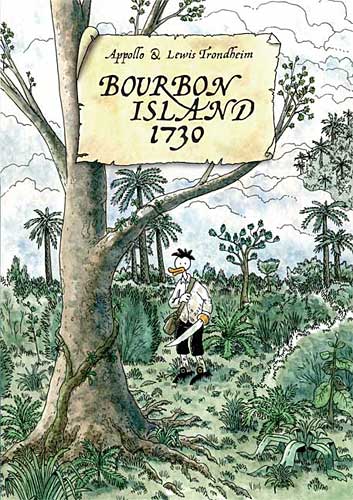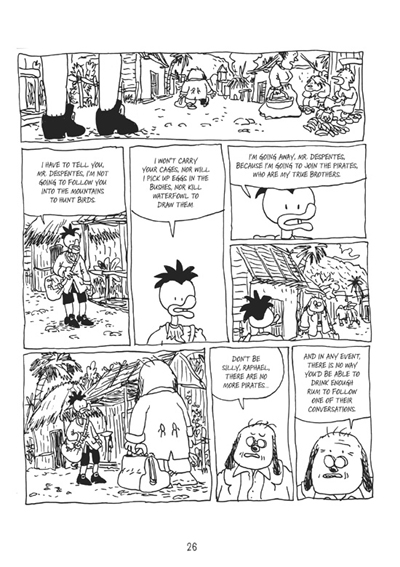
On Sundays, Felan profiles his favourite comics and graphic novels from across the diverse medium’s history.
So far this column has focused on American comics, but this week we’re shifting gears to take a look at one of the most prolific and talented contemporary European creators of bandes-dessinées. Lewis Trondheim is frequently cited as one of the key figures in the renaissance in French comics since the 1990s, driven by small, independent publishing groups. Bourbon Island 1730 is one of Trondheim’s more recent books, and a collaboration with another French BD writer, Appollo. Set at the end of the age of sail on what is now calledReunion Island, far off the coast of Madagascar, former pirates and post-colonial tensions abound!
Characteristic of new-school French BD is a rougher, less polished art style than the ligne claire style of earlier European comics like Hergé’s iconic Tintin. Trondheim’s perfectly squiggly lines are immediately recognizable and hugely endearing. As in much of his work, Trondheim uses anthropomorphized animals (birds, dogs and cats mostly) instead of “realistic” human characters in Bourbon Island, but this is purely stylistic; the story is written straight, with no reference to the way the characters look (no furries here). The comic is in black-and-white, and although Trondheim’s linework is great as-is, one can’t help wishing that the whole book was filled in with the beautiful watercolours he uses on the cover (pictured above).
Bourbon Island is vaguely centred on the experiences of Raphael, assistant to an ornithologist visiting the Island to document the local fauna and search for living specimens of the presumed-extinct dodo bird. Thrilled by sailor’s tales of the golden age of piracy, Raphael dreams of running away to join the pirates and finding the legendary pirate republic of Libertalia when they arrive on Bourbon. In reality, the days of high-seas adventure are at an end, and most of former pirates are either dead, on the lam, or reformed citizens. Somewhat disillusioned but still hopeful Raphael acts as a kind of observer-commentator on the various events happening on the Island.

A group of slaves led by a notorious ex-pirate captain are violently rebelling against their colonist masters while being pursued by vicious bounty hunters. Powerful landowners and politicians manipulate events on the Island to their own advantage. The governor’s daughter sympathizes with and exoticizes the black rebels. Raphael doesn’t really do anything, in spite of his desire for adventure, but he wanders from encounter to encounter, watching and pondering what is being lost as the world moves forward, and collecting stories. Trondheim uses different animals to represent different ethnic and racial groups, and to help animate the conflicts between them – this strategy could easily collapse into awkward stereotyping and generalization, but his style is so expressive that even the most minor characters seems to have a specific individual history.
Questions of race, power, morality, idealism and storytelling all lurk beneath the surface of this smart episodic narrative, and Appollo is careful not to let things get bogged down in commentary. He prefers to simply show things happening, and leave the linking-together to the reader. This ambiguity contrasts remarkably well with Trondheim’s wobbly, cartoony artwork, creating an open-ended but satisfying work of comic historical fiction that walks the line between serious, thoughtful graphic novel and entertaining funnybook, punctuated with both sublime and hilarious moments.
Bourbon Island 1730 is a one-off BD, published in a pretty good English translation by First Second books. The above images are from the publisher’s website, where you can find more information about the book: http://us.macmillan.com/bourbonisland1730
